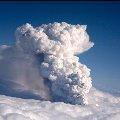The skies above large parts of Europe were empty for a second day Friday, as air safety authorities warned that the cloud of ash from Iceland's volcano is spreading. Brian Flynn, head of operations at the European air traffic control body, addressed a press conference in Brussels.
"Today the situation has deteriorated somewhat," he said. "We would be expecting 29,500 flights today. We think we will only have about 12- or 13,000 flights able to operate. So effectively we will be losing more than 50 percent of the normal passenger movements in Europe today." Civilian aircrafts are right now not flying in Britain, Belgium, the Netherlands, Denmark, Sweden, Norway, Finland, Estonia, the north of France including all Paris airports, northern parts of Germany, parts of Poland including Warsaw airport and the Czech Republic.
And Flynn says the cloud is spreading. "The southern part of Europe is for the most part clear but the volcanic ash cloud is anticipated to extend slightly further south and eastward during this night," he said. The volcano on a glacier in Iceland erupted Wednesday.
The volcano has sent a massive cloud of microscopic ash particles swirling across northern Europe - particles that air specialists say are highly abrasive and could cause aircraft engines to fail.
They could also be bad for people's health, the World Health Organization said Friday. Spokesperson David Epstein says the ash, which is drifting at an altitude of almost 10 kilometers, could be harmful when it hits the ground.
"These are the same kind of fine matter found in normal air pollution. These can be sulfate, nitrate, ammonia, sodium chloride and if these are small particles they can be dangerous because if they are inhaled they can reach the lungs." Epstein says when the ash does settle people should remain indoors as much as possible. The United Kingdom Health Protection Agency warned that the ash could cause itchy eyes, a runny nose, sore throat or dry cough.
Colin Macpherson, a professor of Earth sciences at Britain's Durham University, says it's impossible to know how long the volcano will continue to erupt. The last time this volcano did erupt in the early 19th century, he says, it lasted two years.
"Some volcanic eruptions last for just a few days. Others last for months or even years. There is no clear way of predicting at the present time how long this activity might go on for," he said. But he says, it's because of current wind patterns that the volcano is having such a major affect on European air travel. "It's because we have the prevailing wind at the moment coming from the north, pulling the material down towards Western Europe that we're seeing the impact on the travel of so many people," said Macpherson. In the spring and summer, he says, he would expect the prevailing winds in Western Europe to come from the West or Southwest - which would mean that the ash would be pushed towards the Arctic or Siberia.

